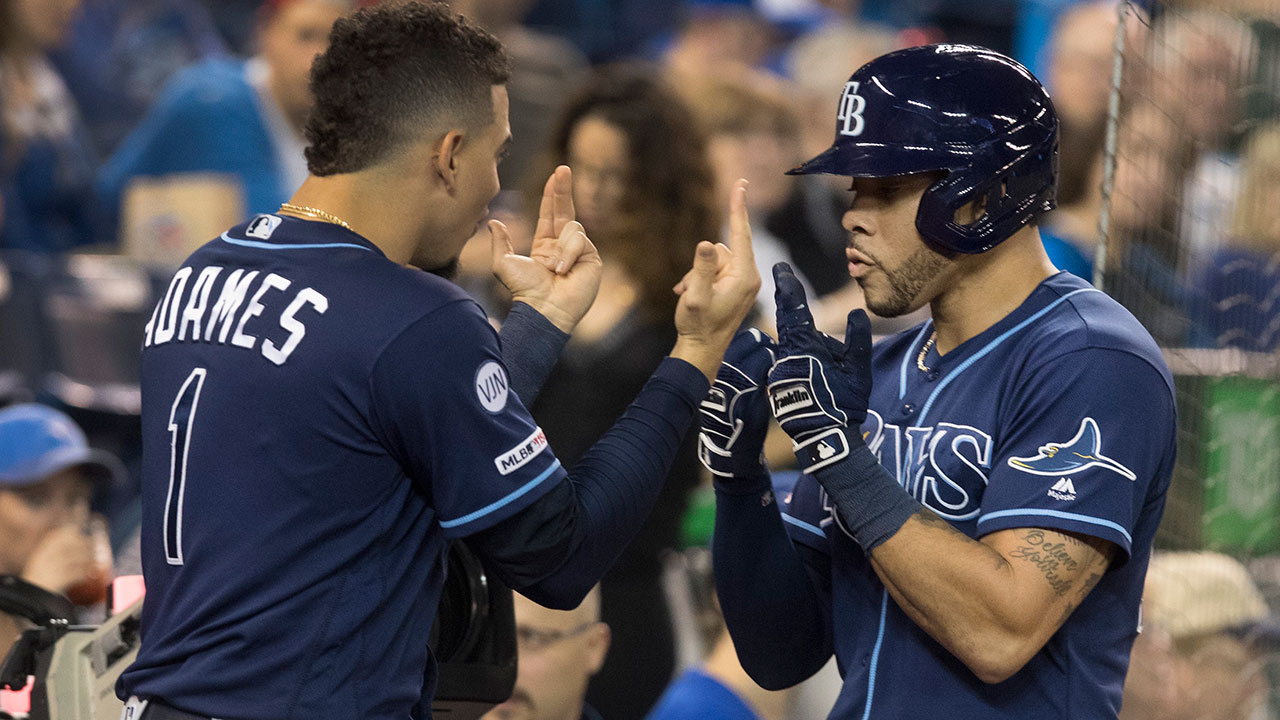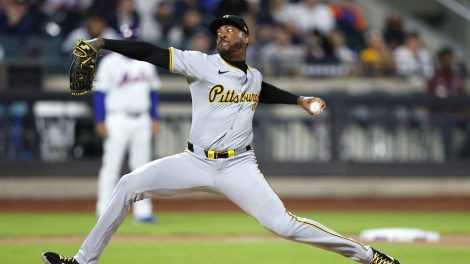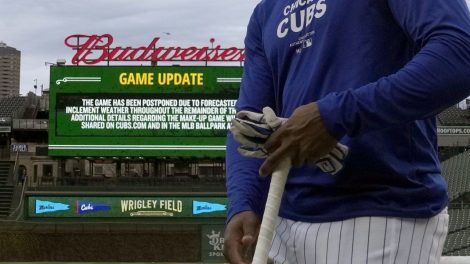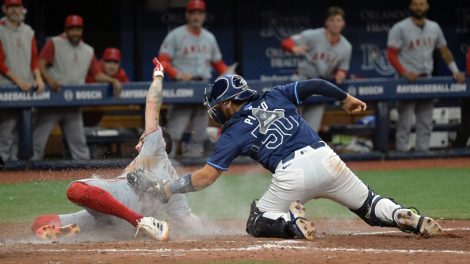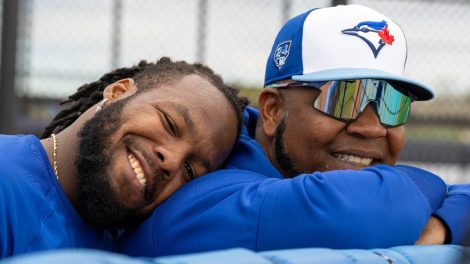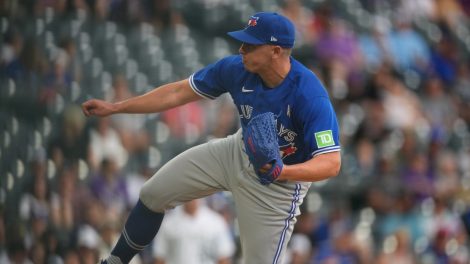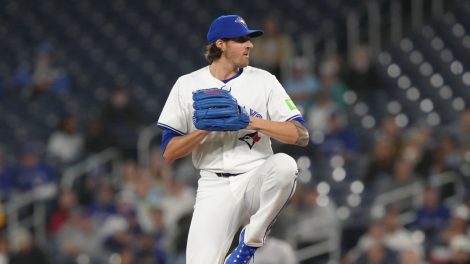TORONTO — On Thursday, Tampa Bay Rays manager Kevin Cash placed a call to old friend Charlie Montoyo, his counterpart with the Toronto Blue Jays. The Rays were coming to town and needed some wins. The Blue Jays were playing out the string of a nearly 100-loss season. Might Montoyo do Cash a solid and lighten up his lineup, perhaps by giving Vladimir Guerrero Jr. a weekend off his feet?
“I told him Vladdy’s kind of struggling right now, so don’t worry about it,” Montoyo joked in his office before Friday’s game. No favours. Toronto’s best played. It didn’t matter, anyway.
Cut to Friday at 10:10 p.m. — the Rays jumping up and down beside the Rogers Centre mound, celebrating a fourth post-season berth this decade, while the Blue Jays looked on from the home dugout, dejected. Bo Bichette and Guerrero Jr. were among the young Blue Jays who idled for a long while after the game, eyeing their ecstatic opponents. Cavan Biggio, too.
“A team like that, a team with that calibre of talent, that’s able to grind in this type of division — it’s good for them, it’s cool to watch,” Biggio said after the Blue Jays fell 6-2. “But it sucks to watch. Even if we are 30 games out, 40 games out.”
Such is the gap between the Blue Jays and the second wild-card spot their divisional foes claimed — 31 games. Meanwhile, it’s 37.5 games to the top of the AL East, where the New York Yankees have won a division title and are off to the playoffs for the fourth time in five years. And it’s been 26 full seasons since the Blue Jays won a World Series, something another division rival, the Boston Red Sox, did just last year, their third championship since 2007. Never forget the Blue Jays exist among giants.
Montoyo remembers being at Fenway Park this April when the Red Sox held their ring ceremony. He hopes that moment, and Friday’s, resonate with his young clubhouse.
“That’s two things that happened this year that we saw that I know are going to happen here — that I know the players, by seeing it, they’re going to say, ‘Okay, that’s going to be us,’” Montoyo said. “I know they’re watching. And I know we’re going to get there.”
The thing is, getting there in the AL East is as challenging a task as any across MLB. Barring dramatic divisional realignment or a shocking turn of fortunes for multiple franchises, the Blue Jays will need to find ways to overcome not two but three juggernauts — the free-spending, traditional ones in New York and Boston, and the economical, relentlessly-savvy one playing out of St. Petersburg, Fla.
[snippet id=4722869]
Of course, Montoyo knows the problem the Rays pose well. He contributed to it, spending his 21 seasons prior to this one working for them — first as a deep-system coach, then as the wildly successful manager of the Durham Bulls, and finally as a vital piece of the big-league staff. He left last winter to seize the first major-league manager job he’d ever been offered, and with a 4-13 record so far against his old club, now understands how frustrating it can be on the other side.
“We’re trying to beat them. We were making all kinds of moves and stuff,” Montoyo said. “But they have pitching and defence. And they stay in the game.”
It’s frustrating because the Rays don’t only have that pitching and defence — they boast the best staff ERA and FIP (both 3.65) in the AL. They’re not only young — their two best hitters, Austin Meadows and Brandon Lowe, are in their age-24 seasons. They’re not only cheap — only $36-million is on the books for 2020 and much of the team’s core has yet to even hit arbitration. They’re not only nasty — Tampa’s staff boasts the fifth-highest average fastball velocity (94.4 m.p.h.) in the game. And they’re not only annoying — they have 39 come-from-behind wins this season (already a dozen more than they mustered in all of 2018) and are 22-9 in their last 31 one-run games, a .710 winning percentage.
They’re all those things and they’re getting better. They have eight players on Baseball America’s top-100 prospect list; six on MLB.com’s top-100; five on Baseball Prospectus’s top-50. They boast, at worst, baseball’s third-best farm system. The Blue Jays have worked diligently and purposefully to push their system into the top-10 of industry rankings over three consecutive losing seasons. The Rays, meanwhile, have merely chugged along in the top-five while posting a .550 major-league winning percentage since 2017.
The Rays win on the margins, on the field and off. They cannot — “will not” is arguably more accurate — spend like most franchises, so they must nail all alternative avenues of talent acquisition. That means executing at an extremely high level in drafting and development, such as getting Brandon Lowe in the third round, Nate Lowe (no relation) in the 13th and Kevin Kiermaier in the 31st, then giving them the resources to grow into everyday big-leaguers.
It means finding and grooming gems from the international market, like Yonny Chirinos, who was signed out of Venezuela for a $10,000 bonus and this season has a 3.65 ERA over 130.2 innings. Or his countryman, Jose Alvarado, who’s pitched to a 3.27 ERA with a 10.8 K/9 over the last three seasons after signing for $50,000. Or Dominican Diego Castillo, who the Rays really splurged on at a price of $64,000, and turned into a lights-out sometimes-reliever, sometimes-closer, sometimes-opener. He’s pitched to a 3.24 ERA with a 10.4 K/9 over 107 appearances since his major-league debut last June.
[snippet id=3305549]
It means making shrewd trades in which marginal prices are paid to acquire underutilized or undervalued talent from other organizations, such as the heist of Austin Meadows (who hit his 33rd home run Friday) and Tyler Glasnow (who went 4.1 scoreless innings) — worth 6.4 fWAR this season, collectively — from the Pittsburgh Pirates in exchange for Chris Archer, he of a 0.7 fWAR in 2019.
Or the 2018 trade of three spare prospects for Tommy Pham, who opened Friday’s scoring with his 21st home run of the season, raising his wRC+ to 121. Or the acquisition of Ryan Yarbrough, an unheralded, fourth-round college pick who was lifted from the Seattle Mariners as part of a package for Drew Smyly. Yarbrough’s pitched to a 3.99 ERA over 284 innings the last two seasons. Smyly got hurt and never even threw a pitch for Seattle.
It means identifying potentially impactful players on the fringes of 40-man rosters across the game and giving them opportunities to realize their potential. Ji-man Choi was designated for assignment on four occasions and spent time with five different organizations before landing with the Rays in mid-2018 and putting up an .827 OPS since. Travis d’Arnaud was released by the New York Mets in May, signed by the Los Angeles Dodgers days later, and acquired by the Rays for cash days after that. He has a 107 OPS+ for Tampa over 126 games since.
Of the club’s 40-man roster, only three players were acquired via free agency. Ten are homegrown while a remarkable 27 have arrived in trade. But on the rare occasions they do spend, the Rays spend wisely, like last off-season’s two-year, $30-million pact with Charlie Morton, who’s pitched to a 3.05 ERA over 194.2 innings in his age-35 season.
And it means finding innovative ways to maximize winning percentages and get the most out of their roster. In 2018, the Rays were the first team to regularly use an opener, a strategy that several teams — including the Blue Jays — have utilized this season, and which will likely be seen in next month’s playoffs.
Defensively, the Rays were shifting more often than any team shy of the Houston Astros as far back as 2016, when they utilized a shift in more than a quarter of plate appearances while 25 of MLB’s 30 teams were shifting less than 20 per cent of the time. This season, with nearly half of MLB teams shifting for more than a quarter of plate appearances, the Rays are still near the top of the game, employing a shift 37 per cent of the time.
“We’ve shifted more this year here than in the past,” Montoyo said. “And it’s because I’ve seen it work on the other side.”
Life’s good on the other side. The franchise that celebrated at Rogers Centre on Friday is cunning, inventive, ruthlessly efficient. A 96-win (and counting) model of how to succeed without the deep pockets and abundant resources of the clubs in New York and Boston. While the Rays coated the visitors’ clubhouse walls in champagne, Blue Jays such as Montoyo and Biggio could only talk about how they’d like to experience that themselves someday. You know, jump up and down on a mound, raise a banner. And maybe they will. If they can fell the giants among them.
[relatedlinks]

